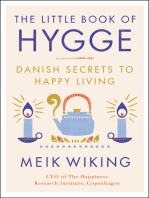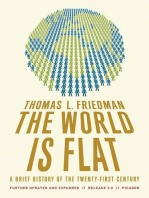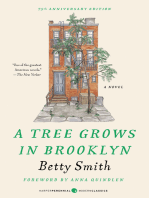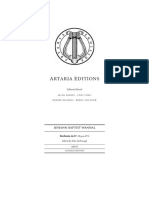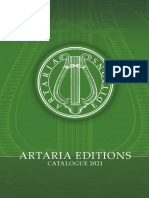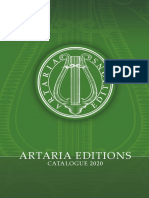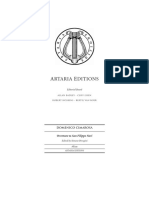0 ratings0% found this document useful (0 votes)
91 viewsAe642 C
Ae642 C
Uploaded by
Artaria Editionsae642_c
Copyright:
© All Rights Reserved
Ae642 C
Ae642 C
Uploaded by
Artaria Editions0 ratings0% found this document useful (0 votes)
91 views24 pagesae642_c
Original Title
ae642_c
Copyright
© © All Rights Reserved
Share this document
Did you find this document useful?
Is this content inappropriate?
ae642_c
Copyright:
© All Rights Reserved
0 ratings0% found this document useful (0 votes)
91 views24 pagesAe642 C
Ae642 C
Uploaded by
Artaria Editionsae642_c
Copyright:
© All Rights Reserved
You are on page 1of 24
ARTARIA EDITIONS
Balitrial Board
ALLAN BADLEY » CLIFF EISEN
ROBERT HOSKINS + BERTIL VAN BOER
LEOPOLD HOFMANN
‘Missa Sancti Erasmi (Badley D4a)
ited by Allan Bad
Ae
AED
LEOPOLD HOFMANN
‘Misa Sancti Era (Badley Da)
Source ~Seitenstetten, BenedltinerstiftD XIL3
Esitor ~All Badley|
Engraving & Layout ~ Promethean Editions Limited
© Artaria Editions Limited 2023
Published by Antara Editions (Hong Kong) Limited in Hong Kong,
ISBN 974-$88-8708-8654 (print)
ISBN 978-688-8708-87-1 (digital)
ISMN 979.0-805700-82-2
aes
FOREWORD
Sgr, comput ie shoe sot H's
pets eben th poston lel es
is private life,
Unlike many professional musicians of the period,
Hofmann was not bor into a family of musicians, His fa-
ther, Georg Adam Hoflimann (6381765), was born in
Bohemia but, like many of his ambitious counteymen, he
Inad moved to Vienna which offered far greater prospects
for advancement. As a young man he had studied jurispru-
dence, and atthe time of Leopold's birth, he was Hofmeister
(tom 1739, Hofkammerdienet) to Count Johann Adam von
Questenberg. While he was not a professional musician,
Hoffmann senior was vitally interested in musical matters,
His letters to Questenberg, which are preserved among the
Questenberg papers in the Moravian State Archives in Brno,
reveal in Jana Perutkova’s assessment, “that he had good taste
and was well versed in all kinds of art, expecially in music.
sical thes
very insightful and show that the author was a musician’
is judgements about music and m ae always
Leopold's godéather-and the man after whom he was named
anections such as
was Count Leopold von Dieteichstein, C
these were important in Vienna and doubtless proved useful
in Hofmann’
later professional advancement.
Hofimann’s musical ability clearly revealed itself early,
and it is possible that his father's connections smoothed
the way for him to join the chapel of the Dowager Empress
Blisabeth Cl
member of the chapel, he received a thorough musical edu-
stine as a chorister in his seventh year. As a
calion and studied keyboard playing and later composition
with the chapel’s organist, Georg Christoph Wagensel, one
of the most progressive composers of instrumental music in
Vienna a this time. Although his violin teacher is unknown,
liana Coun ohana Ati en Gaeta flan pea Sangin Moc
Sears epaesnes (at) Gu at Neat Berl Ove eh Maan!
Mobis ond Ms Mist n Baty Neen Bere: Bop ters
it is possible that he had lessons with Giuseppe Trani, an-
other prominent member of the Dowager Empres#’s chapel,
who taught the young Carl Ditters, After the dissolution
of the chapel in 1750 following Elizabeth Christine's death,
‘Hofmann continued to study privately with Wagensel whose
‘works exerted a strong influence on his development as a
composer.
‘The earliest known compositions attributed to Hofmann
ate from the late 1750s and include symphonies, fate con-
certos and atleast one small-scale sacred work, a setting of an
Alleluja for bass solo, choir, two violins and continue, Sieber’
publication in Paris ofa set of six symphonies by Hofmann
is evidence that his reputation as a composer was well estab-
lished by 1760, and further proof of this ean be found in the
acquisition of his works by a number of the great Austrian
monastic foundations, including Gotwweig, which began
around this time,
‘Hofmann’ first known professional post — as muscu at
StMichaet’s (1758) —was followed quickly by the musical di-
rectorship of St Peter's ca 1764 and, in 1769, appointment as
Klaviermeister at court, a role in which he had been deputis-
ing for Wagensei for several yeas, Many of Hofmann's key-
board concertos like those of Wagenseil, appear to have been
written in connection with hie activities at Klaviermeister
although this did not restrict their wider dissemination,
While he was appointed specifically as Klaviermeister to
the young Archduchess Theresia at the specific request of
Joseph If, Hofmann wrote in his petition for the post of
Hofkapellmeister in 1774 that he had also taught "Their Most
Serene Highnesses the Archduke Maximilian ... Archduchess
Elisabetha, Archduchess Amalia and Archéuchess Josepha’
‘Two years earlier, he had secured the prized position of
Kapellmeist leclined the di-
rectorship of the Hofkapelle on learning thatthe conditions
¢ Stephen's Cathedeal b
of appointment would requize him to relinquish his other
decision to petition
forthe post again in 1774 following the unexpected death
posts including St Peter's
fofmann’
Florian Leopold Gassmann may indicate a change of stance
fn this issue, but in the event the petition was declined in
spite of his being considered the best-qualifed candidate
for the position, A confidential memorandum concerning
the appointment reveals concern that Hofmann’s resigna-
tion from the cathedral would open the way to Tobias Gaur
succeeding to the position, Geur was evidently considered
‘unsuitable and the decision was made to leave Hofmann
‘where he was and bring Joseph Bonno out of rettement to
fill the court post.
‘The politicking involved in the court appointment
say have effectively blocked Hofimann's immediate career
prospects in Vienna, but his personal citcumstances seem
tw have improved dramatically around this time following
his marriage to Maria Anna Kiermayr, the daughter of a
‘goldsmith, on a May 1774.By 1776 Hofmann had acquized a
property in Dobling where he is listed among the benefic~
tors of the parish. The Hofimanns were prominent mem-
bers of their litle community, frequently lending money
to their neighbours to purchase and, undertake improve-
sents o their properties and other matters. The income
they derived from such ventures supplemented Hofmann's
various professional sources of income and enabled he and.
his wife to lead a comfortable and prosperous le
Ttis clear that much of Hofmann’s music was written
‘on commission for other musical institutions and private
individuals even after his appointment to St Stephes's in
17722 How long he remained productive as a composer is
‘uncertain, but it seems likely that majority of his extant
‘works were composed between ca 1760 and 1780, Hofmann,
You might also like
- The Subtle Art of Not Giving a F*ck: A Counterintuitive Approach to Living a Good LifeFrom EverandThe Subtle Art of Not Giving a F*ck: A Counterintuitive Approach to Living a Good LifeRating: 4 out of 5 stars4/5 (5988)
- The Gifts of Imperfection: Let Go of Who You Think You're Supposed to Be and Embrace Who You AreFrom EverandThe Gifts of Imperfection: Let Go of Who You Think You're Supposed to Be and Embrace Who You AreRating: 4 out of 5 stars4/5 (1112)
- Never Split the Difference: Negotiating As If Your Life Depended On ItFrom EverandNever Split the Difference: Negotiating As If Your Life Depended On ItRating: 4.5 out of 5 stars4.5/5 (898)
- Hidden Figures: The American Dream and the Untold Story of the Black Women Mathematicians Who Helped Win the Space RaceFrom EverandHidden Figures: The American Dream and the Untold Story of the Black Women Mathematicians Who Helped Win the Space RaceRating: 4 out of 5 stars4/5 (932)
- Grit: The Power of Passion and PerseveranceFrom EverandGrit: The Power of Passion and PerseveranceRating: 4 out of 5 stars4/5 (619)
- Shoe Dog: A Memoir by the Creator of NikeFrom EverandShoe Dog: A Memoir by the Creator of NikeRating: 4.5 out of 5 stars4.5/5 (546)
- The Hard Thing About Hard Things: Building a Business When There Are No Easy AnswersFrom EverandThe Hard Thing About Hard Things: Building a Business When There Are No Easy AnswersRating: 4.5 out of 5 stars4.5/5 (357)
- Her Body and Other Parties: StoriesFrom EverandHer Body and Other Parties: StoriesRating: 4 out of 5 stars4/5 (831)
- Elon Musk: Tesla, SpaceX, and the Quest for a Fantastic FutureFrom EverandElon Musk: Tesla, SpaceX, and the Quest for a Fantastic FutureRating: 4.5 out of 5 stars4.5/5 (477)
- The Emperor of All Maladies: A Biography of CancerFrom EverandThe Emperor of All Maladies: A Biography of CancerRating: 4.5 out of 5 stars4.5/5 (275)
- The Little Book of Hygge: Danish Secrets to Happy LivingFrom EverandThe Little Book of Hygge: Danish Secrets to Happy LivingRating: 3.5 out of 5 stars3.5/5 (425)
- The World Is Flat 3.0: A Brief History of the Twenty-first CenturyFrom EverandThe World Is Flat 3.0: A Brief History of the Twenty-first CenturyRating: 3.5 out of 5 stars3.5/5 (2272)
- The Yellow House: A Memoir (2019 National Book Award Winner)From EverandThe Yellow House: A Memoir (2019 National Book Award Winner)Rating: 4 out of 5 stars4/5 (99)
- The Sympathizer: A Novel (Pulitzer Prize for Fiction)From EverandThe Sympathizer: A Novel (Pulitzer Prize for Fiction)Rating: 4.5 out of 5 stars4.5/5 (125)
- Devil in the Grove: Thurgood Marshall, the Groveland Boys, and the Dawn of a New AmericaFrom EverandDevil in the Grove: Thurgood Marshall, the Groveland Boys, and the Dawn of a New AmericaRating: 4.5 out of 5 stars4.5/5 (270)
- A Heartbreaking Work Of Staggering Genius: A Memoir Based on a True StoryFrom EverandA Heartbreaking Work Of Staggering Genius: A Memoir Based on a True StoryRating: 3.5 out of 5 stars3.5/5 (232)
- Team of Rivals: The Political Genius of Abraham LincolnFrom EverandTeam of Rivals: The Political Genius of Abraham LincolnRating: 4.5 out of 5 stars4.5/5 (235)
- Kraus Viola Concerto No. 1 Viola Solo PreviewDocument4 pagesKraus Viola Concerto No. 1 Viola Solo PreviewArtaria EditionsNo ratings yet
- On Fire: The (Burning) Case for a Green New DealFrom EverandOn Fire: The (Burning) Case for a Green New DealRating: 4 out of 5 stars4/5 (75)
- AE616 Score - eDocument14 pagesAE616 Score - eArtaria Editions0% (1)
- Kraus Viola Concerto No. 2 Viola Solo PreviewDocument4 pagesKraus Viola Concerto No. 2 Viola Solo PreviewArtaria EditionsNo ratings yet
- The Unwinding: An Inner History of the New AmericaFrom EverandThe Unwinding: An Inner History of the New AmericaRating: 4 out of 5 stars4/5 (45)
- ae633_cDocument15 pagesae633_cArtaria EditionsNo ratings yet
- Ae638 CDocument16 pagesAe638 CArtaria EditionsNo ratings yet
- Ae642vs CDocument24 pagesAe642vs CArtaria EditionsNo ratings yet
- Ae652 CDocument16 pagesAe652 CArtaria EditionsNo ratings yet
- Ae637 CDocument16 pagesAe637 CArtaria EditionsNo ratings yet
- Ae559 CDocument24 pagesAe559 CArtaria EditionsNo ratings yet
- Ae622 CDocument12 pagesAe622 CArtaria EditionsNo ratings yet
- Ae621 CDocument12 pagesAe621 CArtaria EditionsNo ratings yet
- Ae620 CDocument12 pagesAe620 CArtaria EditionsNo ratings yet
- Ae647 CDocument10 pagesAe647 CArtaria EditionsNo ratings yet
- Saint-Georges, Joseph Bologne De: Six String Quartets, Op.1 (AE619)Document16 pagesSaint-Georges, Joseph Bologne De: Six String Quartets, Op.1 (AE619)Artaria Editions100% (2)
- Rtaria Ditions: Violin Concerto in G, Op.2 No.1Document20 pagesRtaria Ditions: Violin Concerto in G, Op.2 No.1Artaria EditionsNo ratings yet
- Artaria Editions Catalogue 2021Document92 pagesArtaria Editions Catalogue 2021Artaria EditionsNo ratings yet
- Ae628 CDocument12 pagesAe628 CArtaria Editions100% (1)
- Rtaria Ditions: Symphonie Concertante in C, Op.6 No.1Document16 pagesRtaria Ditions: Symphonie Concertante in C, Op.6 No.1Artaria EditionsNo ratings yet
- Ae586 C PDFDocument23 pagesAe586 C PDFArtaria EditionsNo ratings yet
- Artaria Catalogue 2020Document92 pagesArtaria Catalogue 2020Artaria EditionsNo ratings yet
- Ae591 C PDFDocument23 pagesAe591 C PDFArtaria EditionsNo ratings yet



















